Having a garden with different shrubs and bushes in your backyard is great. It makes your day start well.
In gardening, we plant many flowers, bushes, and shrubs. This is how we enjoy nature’s beauty.
Most bushes are 2-3 feet tall, but some can be up to 10 feet. This size makes them look good and special. Bushes and shrubs are not hard to care for.
Even if you are busy, you can look after them well.
Do You Want to Grow Bushes in Your Yard?
Choosing the right ones can be a bit hard because there are so many different types of bushes. They add color to your yard.
When you pick shrubs for your garden, it’s good to choose ones that don’t need a lot of work and are easy to look after.
You can change how your garden looks easily if you pick the right shrubs.
In this blog, we will show you different bushes that you can grow in your yard without too much trouble.”
1. Photinias
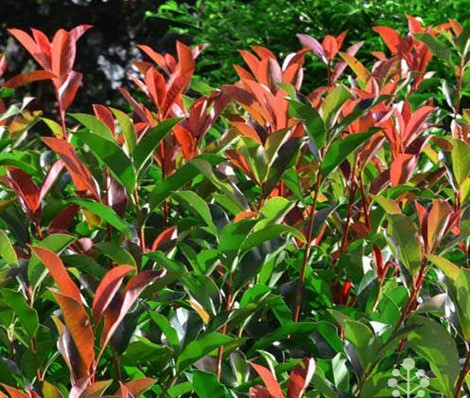
Photinias stand out as taller shrubs, ideal for bringing a lush, green look to your garden. They are particularly notable for their striking red leaves that appear in the warmer months of summer and spring.
This variety of plants adds a significant ornamental quality with its stunning foliage.
Growing to a height of 4-5 feet, Photinias can effectively serve as a natural border or fence in your yard, offering both beauty and a sense of privacy.
If your garden needs a taller plant, Photinias are an excellent choice due to their height and dense foliage.”
2. Hydrangeas

Hydrangeas are not just beautiful; they are fascinating too. These bushes are known for their vibrant, large flowers in blue, pink, purple, and red, which can change color based on the soil’s acidity.
Planting them in early spring or fall allows them to establish and bloom throughout the year. Hydrangeas are ideal for easy-care gardens, thanks to their expansive flowers that cover the ground and bloom mainly in early spring and rainy seasons.
They thrive in Hardiness Zones 3-9, reaching a height of 3-10 feet.
Hydrangeas can grow in direct or partial sunlight, making them a top choice for gardeners with busy schedules who still want a touch of color and elegance in their gardens.
3. Daphne Odori

Daphne Odori, also known as the ‘Siren’ among plants, stands out with its stunning pink and purple flowers that bloom in late winter and early spring. This medium-sized shrub adds a splash of color with its wide green leaves and yellow edges.
An interesting fact about Daphne is that while it’s beautiful, its leaves are poisonous to both pets and humans, so it requires careful handling.
Growing 3 to 6 feet tall, it thrives in Hardiness Zones 7-9 and prefers loamy soil with direct or partial sunlight.
Daphne has a unique, shorter lifespan, typically around 10 years, making it a distinctive choice for a garden with its brief yet vibrant presence.
4. Wintercreeper Vines
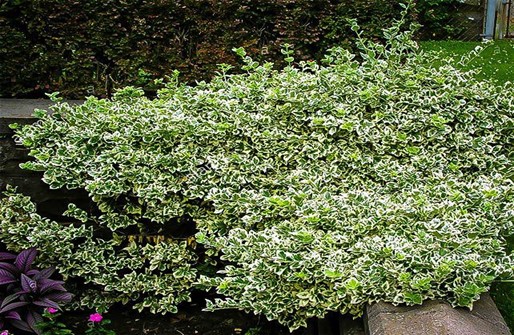
Wintercreeper Vines are a delightful addition to any garden, known for their dual-toned green and white leaves. They are unique among types of bushes because they are evergreen and provide excellent ground cover.
These vines are climbers, perfect for adorning garden walls or trellises. An interesting fact about Wintercreeper is its adaptability; it thrives in USDA Hardiness Zones 5-9 and can grow in various light conditions, from full sun to full shade.
This versatility makes it a fantastic choice for gardeners looking to add lasting greenery and enhance their garden’s overall look.
5. Box Plant
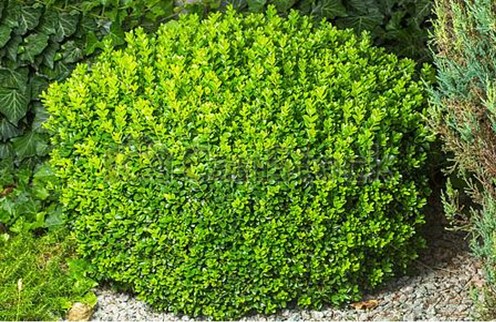
Box Plants are known for their versatility, allowing you to shape them as you like for your garden. These evergreen shrubs, with their thick greenish-yellow leaves, are a classic choice for garden frontiers.
An interesting aspect of Box Plants is their slow growth rate, allowing for precise shaping. Depending on the region, these plants can range from 3 to 30 feet.
You often see Box Plants in large public gardens, beautifully sculpted. They grow in Hardiness Zones 5-8 and are scientifically known as Buxus.
With their adaptability to partial sunlight and various soil types, from sandy to heavy clay, they are a practical and aesthetically pleasing choice for gardens.
6. Camellias
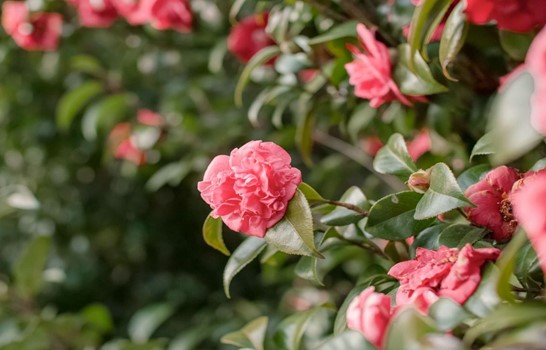
Camellias are a stunning addition to any garden, known for their eye-catching beauty. Planting these in your yard brings a burst of colors during the summer.
Camellias have an impressive range of 3000 hybrids, offering a wide variety of choices. Their flowers come in red, pink, and white, adding a floral elegance to your space.
An interesting fact about Camellias is their adaptability; they can be planted against a garden wall for a decorative effect.
They thrive in Hardiness Zones 7-9, needing direct or partial sunlight to bloom throughout the year.
Camellias are also easy to maintain, making them suitable for busy gardeners.
7. Fatsia Japonica
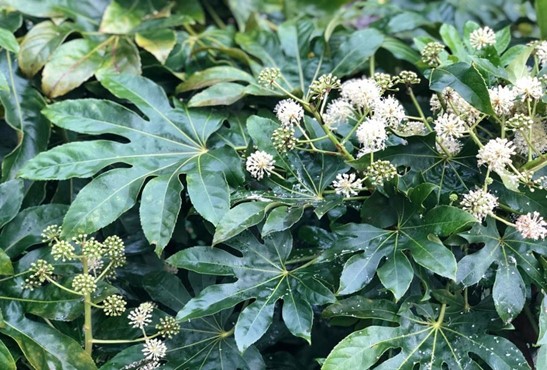
Fatsia Japonica, ideal for those who appreciate large leaves, grows faster than many other shrubs. Its shiny green leaves can reach up to 45 cm in length, making it a visually striking choice.
This shrub is both hardy and robust, staying green all year round and requiring minimal maintenance. An interesting fact about Fatsia Japonica is its bloom of tiny white flowers, adding a decorative touch to gardens.
It thrives in Hardiness Zones 7-10, growing 5-8 feet tall. This adaptable plant can grow in partial sunlight and suit various soil types.
8. Japanese Laurel

Japanese Laurel, or Aucuba Japonica, is an evergreen shrub that captivates with its long leaves and small red berries. The berries, blooming in fall, provide a stunning display of red in your garden.
This shrub is robust and versatile, suitable for shaded areas or garden corners. An interesting aspect of Japanese Laurel is the variety of leaf colors available, alongside the decorative red berries.
It thrives in Hardiness Zones 6-10, reaching a length of 6-10 feet.
Adaptable to partial sunlight or full shade, Japanese Laurel is easy to care for, making it a practical and attractive choice for any garden.
9. Dogwood

Dogwoods are not only beautiful but also versatile. Known for their red bark stems and lovely pink and white leaves, these shrubs can bring a vibrant touch to any garden.
Planting Dogwood means adding a spectrum of colors to your yard. Easy to manage, Dogwoods produce shades of pink, red, and white, ideal for creating contrasts with other garden plants. K
nown scientifically as Cornus alba, they prefer hardiness zones under 3 degrees.
These shrubs can reach up to 10 feet in length and spread about 6 feet wide, thriving best in areas with ample sunlight.
10. Azalea
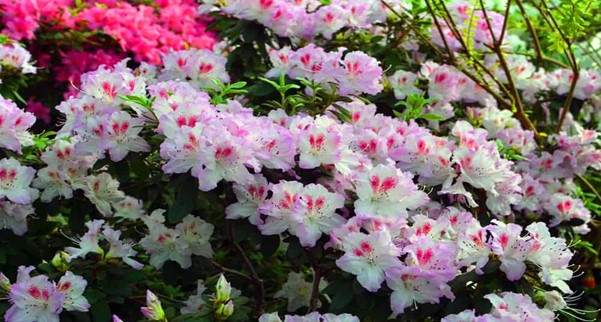
Azaleas, scientifically known as Rhododendron Tsutsusi, are a vibrant choice for any garden, offering a stunning array of 12 different shades, including pink, yellow, white, and purple.
These bushes are cherished worldwide for their versatility and beauty. They bloom in late summer and early spring, showcasing various sizes and shapes.
Azaleas are remarkably resilient, enduring harsh winters and intense sunlight. Growing 8-9 feet tall, they thrive in Hardiness Zones 3-9 and prefer partial sunlight.
These low-maintenance shrubs are perfect for gardeners who want beauty without constant care.
11. Siberian Carpet Cypress

Siberian Carpet Cypress, scientifically known as Microbiota decussata, is an exceptional ground-covering shrub. It creates a beautiful ‘green carpet’ effect in gardens, perfect for large spaces.
This low-growing shrub forms a dense layer of green leaves, adept at withstanding diverse weather conditions throughout the year.
Its ability to cover the ground extensively makes it a popular choice for landscapers.
Thriving in Hardiness Zones 2-7, it flourishes in full sunlight and requires minimal maintenance, making it an ideal choice for busy gardeners looking for a resilient, evergreen addition to their outdoor spaces.
12. Persian Shield

The Persian Shield, known scientifically as Strobilanthes dyerianus, is a unique shrub that stands out with its stunning purple and green leaves. This plant is ideal for adding depth and darker tones to your garden.
Notably, it’s an evergreen that maintains its leaves in harsh conditions. Thriving best in warm climates, it’s versatile enough to be grown indoors as a houseplant.
The Persian Shield requires full sunlight and rich, well-drained soil.
It grows well in Hardiness Zones 9-10, making it a striking and adaptable choice for gardeners seeking to enhance their garden’s visual appeal with vibrant foliage.
13. Blue Star Juniper
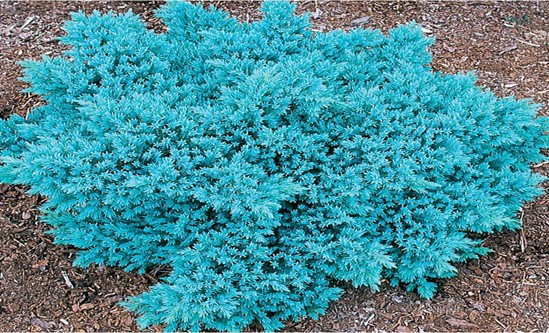
Blue Star Juniper, known scientifically as Juniperus Squamata, adds a unique blue hue to gardens. This variety of Juniper is low-growing and offers a striking ground cover with a silvery effect.
Its ease of care makes it suitable for all gardeners, even those new to gardening. This shrub thrives in Hardiness Zones 4-8 and can withstand tough climate conditions.
While it grows less in height, it spreads out 3-4 feet, creating a lovely, dense cover.
The Blue Star Juniper is a perfect choice for adding a touch of blue and enhancing the color palette of your garden.
14. Rose of Sharon

Rose of Sharon, or Hibiscus Syriacus, is a visually stunning shrub that produces flowers in shades of red, pink, light blue, and white.
Despite its name, it belongs to the Mallow family, not the Rose family. Planting different colors of this shrub can add a vibrant array of hues to your garden.
Also known as Chinese hibiscus, rose mallow, Althea tree, and Korean rose, it thrives in Hardiness Zones 5-8.
Growing 8-12 feet tall, the Rose of Sharon needs well-drained soil and does best in direct or partial sunlight.
15. Purple Ninebark
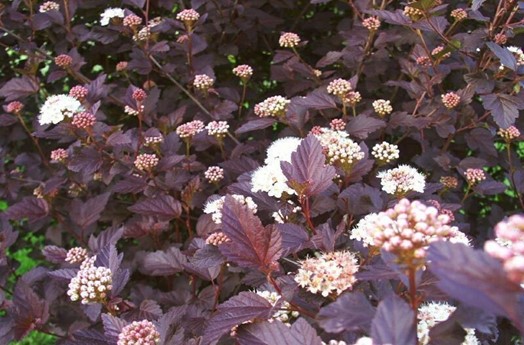
Purple Ninebark, or Physocarpus opulifolius Monlo, is a striking deciduous shrub known for its purple-hued leaves and white flowers, belonging to the Rose family.
It’s a fast-growing plant, reaching up to 10 feet tall, and blooms in early summer and late spring.
Known also as Diablo ninebark and purple-leaved ninebark, it thrives in Hardiness Zones 3-7.
The combination of purple leaves and white flowers makes it a visually appealing addition to any garden, requiring direct or partial sunlight for healthy growth.
16. Dwarf Norway Spruce
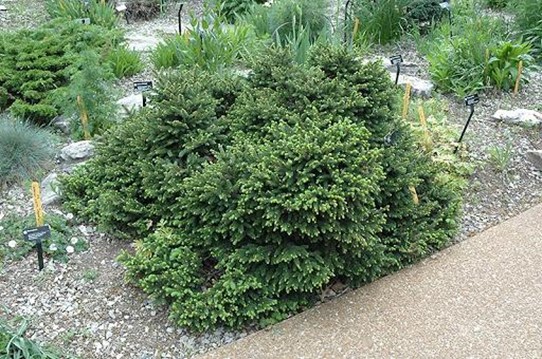
Dwarf Norway Spruce, or Picea abies, is a versatile, low-growing shrub suitable for both indoor and outdoor spaces.
Ideal for small gardens or as a charming corner piece, it forms a cushion-like shape with shiny yellowish-green leaves.
Known affectionately as ‘Little Gems’, these bushes add a unique touch with their compact size.
They grow to 10-12 inches in length and width, making them perfect for confined spaces.
Thriving in Hardiness Zones 3-8, the Dwarf Norway Spruce is an excellent option for adding a quaint, evergreen element to diverse garden layouts.
17. Yew Densiformis

Yew Densiformis, or Taxus media, is a versatile evergreen, perfect for small spaces. It offers ample ground coverage, making it ideal for gardeners looking to maximize their limited area.
Not only does it provide lush greenery, but it also produces soft, needle-like leaves and red berries in summer and spring.
For those who need a larger plant, the Yew family has options to meet different size requirements.
Thriving in Hardiness Zones 4-7, this shrub grows 3-4 feet tall and spreads 4-6 feet wide.
It adapts well to both full and partial sun and various soil types.
18. Mountain Laurel
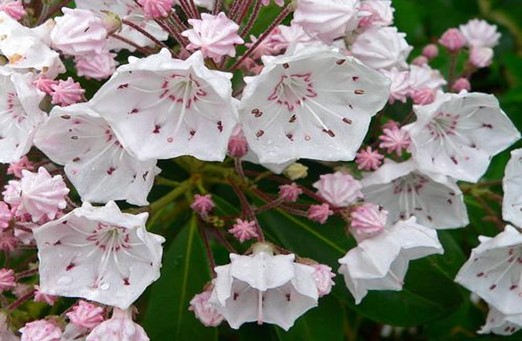
Mountain Laurel, scientifically known as Kalmia latifolia, is renowned for its beautiful white flowers that bloom in late spring and summer.
It’s a broadleaf evergreen shrub, making it a focal point of any garden. With several varieties available, it’s easy to find one that fits your garden’s needs.
Mountain Laurel thrives in USDA Zones 5-9, reaching 3 feet in height and width. It flourishes in direct to partial sunlight, ensuring its white blossoms are a standout feature.
Its adaptability and striking blooms make it a popular choice among garden enthusiasts.
Wrapping Up!
Selecting the ideal types of bushes for your garden is key to creating a space that’s both beautiful and manageable.
A garden brimming with colorful shrubs and blossoms is a delightful sight, especially during your morning routine.
Whether you’re a seasoned gardener or a beginner, the joy of nurturing these plants can be deeply rewarding.
The range of shrubs discussed here offers a variety of options to suit any garden style.
Remember, the right choice of bushes can transform your garden into a vibrant, evergreen haven.

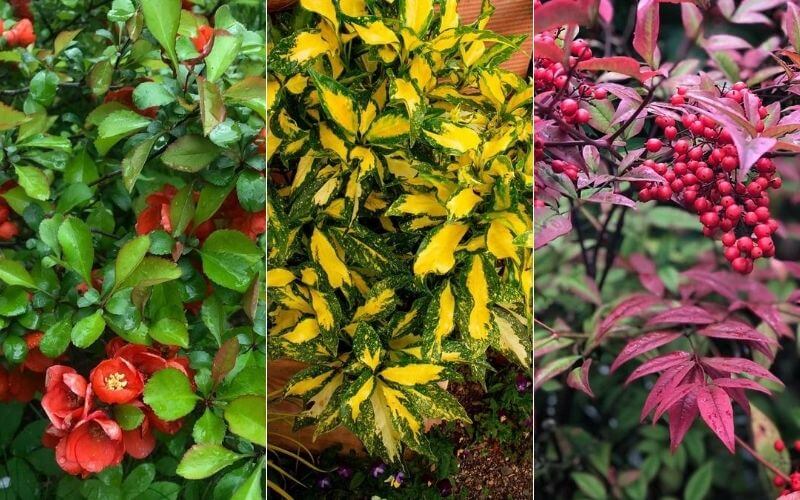
Thanks for the great info. I have a huge yard with too much grass. Trying to eventually eliminate the grass & plant various small shrubs, trees, perennials, etc.
Also want to make a frog pond and paths about the yard where one can relax and the butterfly’s, bees and birdies can call home. Just don’t know where to start. I did purchase 22 small 5 qt. Yew bushes, l would like to make 2 separate hedges with 10 along the short wood fence line and 12 along the front entrance sidewalk.
Dealing with blocking of new train tracks being installed across the street.